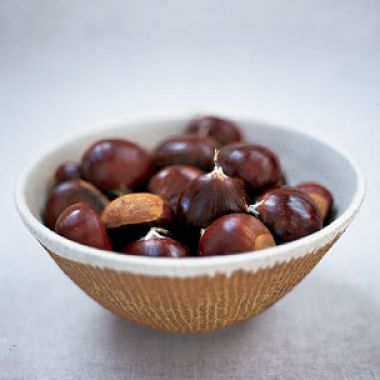
An essential ingredient in virtually every cuisine, nuts provide richness, flavor, body, crunch and vital nutrients in dishes both sweet and savory. In their purest form, with their varied shapes and hues, unshelled nuts piled high in a festive bowl help mark the autumn season.
Chestnuts, known as maroons in France, are large and wrinkled and have a smooth, shiny, mahogany-colored shell shaped like a turban slightly flattened on one side. Unlike other nuts, they contain a high amount of starch and little oil. Often treated as a vegetable and almost always cooked, such as in a pureed soup or mixed with brussels sprouts, sweet and rich chestnuts are also popular simply roasted whole and eaten while still hot.
You must cook chestnuts by briefly roasting or boiling them to loosen their tough outer shells and thin, bitter skins. If you let the chestnuts cool after roasting or blanching them, they will again become difficult to peel. If they do cool, simply return them to a hot oven or hot water for 5 minutes to warm them up. For large amounts, roast or blanch and peel the nuts in batches, working steadily.
Adapted from Williams-Sonoma Kitchen Companion: The A to Z Guide to Everyday Cooking, Equipment and Ingredients (Time-Life Books, 2000)











